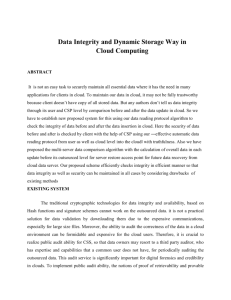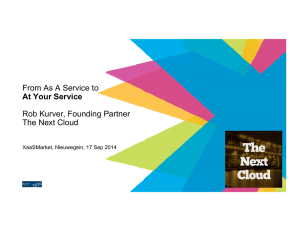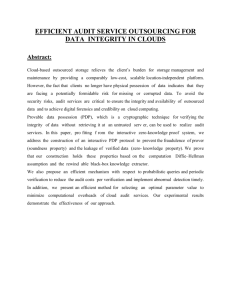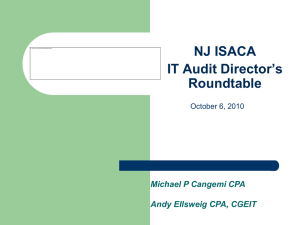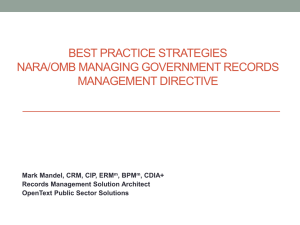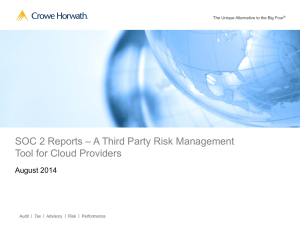VT PowerPoint Template - Information Technology Services
advertisement
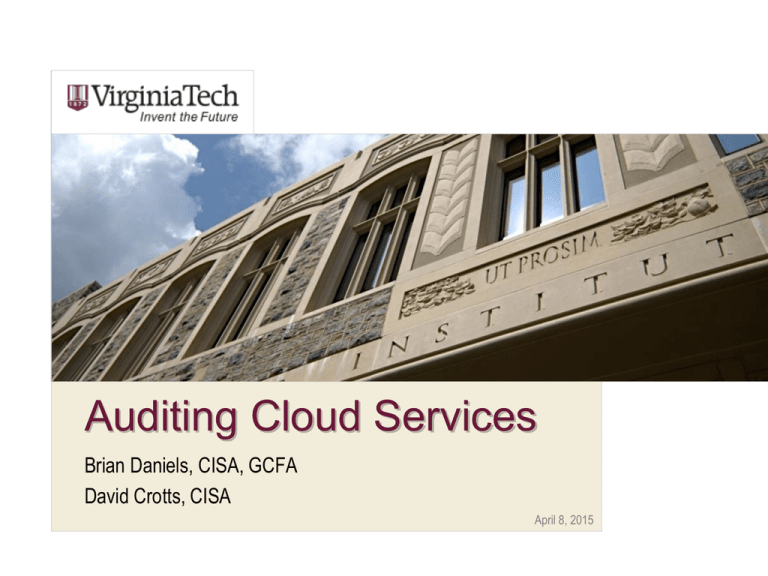
Auditing Cloud Services Brian Daniels, CISA, GCFA David Crotts, CISA April 8, 2015 Overview • Introduction to cloud services in a decentralized environment • Audit perspective of cloud service risks • Conducting the audit • Outcomes • Questions or comments 2 Why Utilize Cloud Services? Who Uses Cloud Services? How Can You Identify Cloud Service Implementations? What is Virginia Tech’s Cloud Service Environment Like? INTRODUCTION 3 Why Use Cloud Services • • • • 4 Collaboration Need for excess storage Lack of resources to manage internally Cost effective Who Uses Cloud Services • • • • • • 5 Researchers IT Professionals Administrators Students Alumni EVERYONE! How to Identify Cloud Services • Request info from Central IT • Request info from Departments • Query technology related expenditures • Account Codes • MCC • Unlikely to identify all 6 Control Environment at VT • Departmental purchasing authority. • Difficult to identify all purchases. • Purchase records only show vendor, not product detail. • What about free services? • Mobile device apps? 7 Control Environment at VT • Guidelines suggest reviews by: • Central IT (Security, Network) • Data Stewards • Legal Counsel • Is it realistic? 8 Risk Environment Risk Assessment Contract Risks CLOUD SERVICES RISKS 9 Risk Environment • Risks of outsourcing are similar to risks of operating internally . • Additional risks exist when the system is outside of your control. • Low cost/free services vs. high cost? • How do you monitor these risks? 10 Risk Assessment • A need has been identified. • What could go wrong utilizing a cloud service provider? • What is the worst possible outcome? • What is a more likely outcome? • What am I exposing myself to? 11 Risk Assessment • What data elements will be utilized? • Are there any regulatory requirements? • • • • • 12 FERPA HIPAA ITAR PCI PII Risk Assessment • What risks are significant enough to warrant special consideration in contract negotiations? 13 Contract Risks • Who has signature authority? • Click through agreements? • Does the defined service adequately represent the identified need? • How complete is the audit clause? • Client access to audit vendor performance. • Client access to review third party audits. 14 Contract Risks • Does the agreement require acknowledgement of regulatory compliance? • Who owns the data once it’s in the cloud? 15 Contract Risks • What invokes the termination clause and what does it address? • • • • 16 Access to data upon termination. Secure removal of data. Termination fees or waiver of fees. Responsibilities of each party upon termination. Contract Risks • Service Level Agreements • • • • 17 Are they complete? Are they reasonable? What is the measurement period? What is the penalty for non-compliance? Contract Risks • Are the specific obligations explicitly stated in the contract? • If not, where are they located? • Policies, procedures, or privacy statements are typically subject to change without notice. • Click through agreements may also change without notice. 18 Contract Risks • Do the elements of the contract apply to any subcontracted vendors? • Negotiation of appropriate contract terms is an effective means to reducing risk exposure. • It is often not possible to get all desired terms and conditions in the contract. 19 Sampling Document Requests Audit Testing CONDUCTING THE AUDIT 20 Sampling • What factors exist in the population? • • • • 21 Users Type of service Functional Use Cost Sampling • Select a cross section • • • • 22 Single user to organization wide Application or storage Administrative, teaching, research High cost, low cost Documentation Request • Planning Documentation • • • • 23 Risk assessments Steering committee minutes Product reviews Security reviews Documentation Request • Original and most recently executed contract. • Most recent SLA performance review • Most recent third party audit report • Preferred report is the SOC 2 Type 2 24 Testing • Risk assessment • Centrally created questionnaire • Only required for purchases greater than $2,000 • Yes/No responses • Developed in 2011 25 Testing • Steering Committee Minutes • No steering committee for most department specific purchases • Expected for central systems purchases (i.e. email, business intelligence software) 26 Testing • Security Reviews • Performed on 4 of 5 services with a cost greater than $2,000 • Not performed on smaller dollar purchases • IT Security Office provides an opinion on the security architecture of the service • Has resulted in corrective action by the vendor. 27 Testing • Signature Authority • Department and Central authorization OK • Data steward review was often absent • Based on the data utilized by the service • Legal Counsel review was often absent 28 Testing • Terms and Conditions • Audit Clauses • One audit clause gave the vendor the right to audit Virginia Tech! • Termination agreements • Beware of data retrieval and removal provisions • Definition of adequate and robust SLAs 29 Testing • Terms and Conditions • Subcontractors • Use of subcontractors permitted? • Enforcement of parent contract to subcontractors? • Regulatory compliance requirements? • Personnel vetting? 30 Testing • Contract Monitoring • Periodic review of Terms and Conditions • Still reflect current operating environment? • What changes have occurred? • SLA Performance • Third party audit reviews • Identified one subcontractor who had significant data breaches occur in 2009. 31 OUTCOMES 32 Outcomes • Risk assessment questionnaire • Revised questions to target specific risks and help assess data elements used and need for ongoing monitoring. • Expanded scope to include items under $2,000. 33 Outcomes • Communication and Training • Ensure adequate knowledge of the risks of outsourcing for department staff. • Focus on training business staff and IT professionals. 34 Outcomes • Assess the impact of restricting use of certain MCC codes on selected Pcard holders. • Manage the risk at the point of procurement by limiting the number of people able to purchase such services. 35 Outcomes • Establishment of preferred standard contract language. • Joint effort led by IT Acquisitions in collaboration with Procurement, Legal Counsel, and Central IT. 36 Outcomes • Processes and procedures designed to help manage and monitor contracts. • Led by IT Acquisitions with input from Central IT or other administrative functions. 37 QUESTIONS OR COMMENTS? 38




